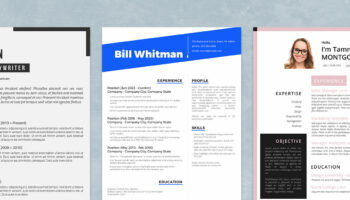You are in full swing of resume writing. You have your list of skills ready, accomplishment lined up, and all sections organized. Is there anything missing? The professional references. But hold on! Do they actually need to be on your resume? Let’s dig in!
Do You Put References on a Resume?
The short answer is — it depends. Normally, you don’t need to put references on your resume. But there are a few exceptions. First, you should have references on your resume when applying for a federal job or another government position. Next, you should add them when the job listing or the hiring manager asks you to do so.
Here are three quick tips to help you decide when to put references on your resume and when to leave them off:
- Didn’t see any mention of references in the job description? Leave them off. You won’t be penalized for doing so.
- Keep some of your references (or ask for new ones) for the interview. Doing so gives you extra time to research the company, understand what they do, and line up the best set of references, based on that information.
Finally, if you are going to include references, you will need to create a separate resume reference page and format it accordingly.
How to List References on a Resume
The standard practice for listing references is to create a resume reference page and send it over with your one-page resume. You don’t need to try and squeeze your references as another resume section!
Instead, open a blank page in Word and use this quick example to format your references.
Here’s how format references on a resume:
- Give your page a simple title. For example [Name Surname: References]
- Provide all the necessary details of your reference person: full name, company, job title, contact details.
- There are no particular rules about formatting each entry. Just be certain the formatting is consistent from one entry to another.
- Use adequate space in between entries.
- Add a minimum of three references.
If you decide not to include references, don’t mention them at all. There is no need to write ‘References available upon request.’ It makes your resume look dated.
Professional Resume Reference Example
Michaela Turner
Western Logistics
VP of Marketing
Mturner@westernlog.com
(555)222-3333
Mr. Turner was a direct supervisor for 5 years.
Jemima Thorn
Urban Corps
Lead Generation Manager
JThorn@urbancorps.com
(555)444-3333
Ms. Thorn managed and coached me during my tenure.
Decide How Many References You Need
OK, now that you know how to format a resume reference page, let’s get you those references.
How much do you need? As a rule of thumb, you should have between 3-5 references, unless the employer specified another number. It’s best if your references come from different companies/organizations.
But if that’s not feasible, add a quick note explaining who one reference is different from another. For example, you can add your direct supervisor and a colleague who could speak to your team working abilities.
Should I Have Personal or Professional References on My Resume?
A professional reference attests to your professionalism and past achievements. As a rule of thumb, most hiring managers would prefer to receive a set of professional references or letters of recommendation since an attestation from a professional contact provides more insight into the applicant’s core competencies and workplace behaviors. This is why it is generally better to use professional references on your resume.
However, you may use personal references if you don’t have enough work experience or want a reference to validate your character and work ethic. Personal references are perfectly acceptable for students, entry-level workers, volunteers, or professionals in the service industry.
How to Ask for a Resume Reference
Got a shortlist of candidates? Now, it’s time to let those people know you are using them as your references. Never list someone without a heads-up!
Here are a few quick tips for requesting a reference:
- Use a bit of flattery, but don’t fawn.
- Explain why you’ve chosen them.
- See if they have preferred contact information (e.g. email over the phone)
- Ask for one or two references more than you need if someone else doesn’t respond.
Here’s a brief sample request:
Hi Dr. Johnson,
I hope things are going well for you, and that Westside Medical Clinic is as successful as ever. I am writing to you because I am in consideration for the position of head nurse at Regional hospital. Would it be okay if I used you as a reference?
They are seeking someone with both clinical and supervisory experience for this position, and who can understand the needs of low-income patients. Because we worked together managing the City Free Clinic, I thought you could speak to my abilities in these areas.
If you would be willing to be contacted by my potential employer, please let me know your preferred contact information.
Sincerely,
Rhonda Black
To Conclude
You don’t absolutely need to put references on every resume you are filing. Do so only when you are explicitly instructed to do so. And that’s good news! Because instead of chasing down those references, you can focus on polishing your resume and cover letter!






